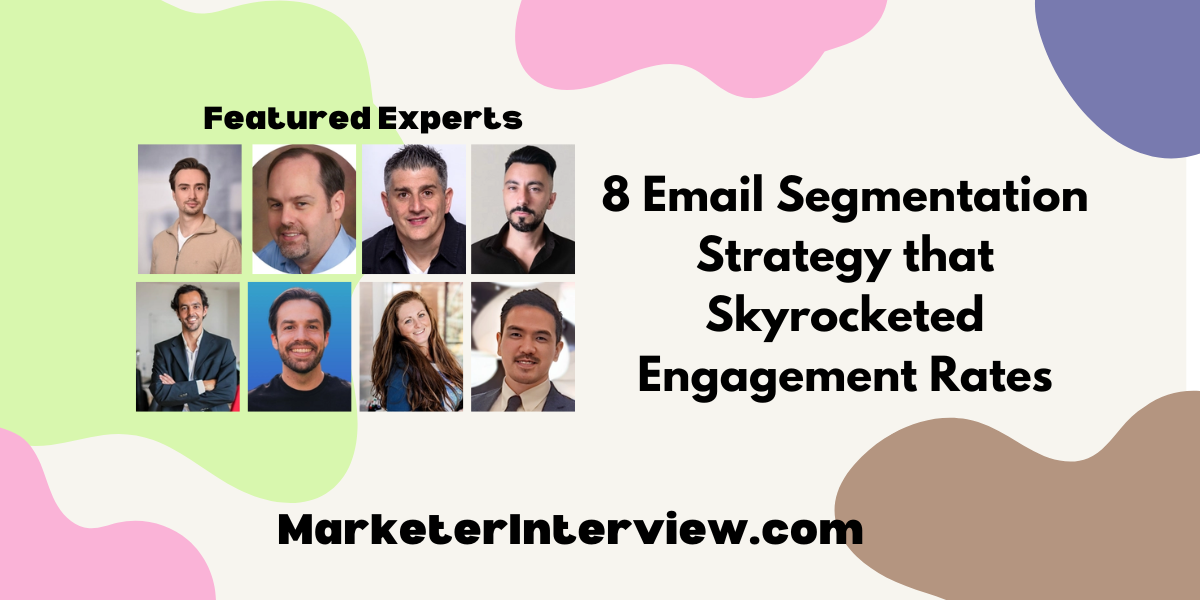8 Email Segmentation Strategy that Skyrocketed Engagement Rates
In the quest for higher engagement in marketing campaigns, we’ve gathered insights from CEOs and marketing experts to reveal the power of email segmentation. From implementing a detailed segmentation strategy to tailoring content to buyer personas, explore the diverse tactics that led to success in our collection of eight transformative strategies.
Want to get quoted in MarketerInterview.com content just like this? Apply to become a contributor today!
Contents
- 1 Implement a Detailed Segmentation Strategy
- 2 Micro-Segment by Industry and Title
- 3 Segment Users by CRM Interaction Patterns
- 4 Score Subscribers Based on Engagement
- 5 Base Segmentation on User Activity Levels
- 6 Tailor Emails to Webinar Attendees
- 7 Categorize by Purchase History Narratives
- 8 Personalize Content by User Behavior
Implement a Detailed Segmentation Strategy
We once faced the common challenge of engaging a diverse client base through generic email campaigns, which often resulted in mediocre open and click-through rates. Our breakthrough came when we implemented a detailed segmentation strategy based on both demographic data and user behavior. This approach allowed us to tailor our content to meet the specific interests and needs of different segments.
For example, we created separate email lists for clients interested in technology scouting versus those looking for market validation services. We went a step further by analyzing past interactions to customize the timing of our emails, optimizing when they would be most likely to engage based on their previous activity patterns. This strategy was put to the test during a campaign aimed at promoting a new service offering. The results were outstanding: our engagement rates soared, with open rates doubling and click-through rates increasing by over 60%.
This success was not just a win in terms of numbers. It deepened our understanding of our clients’ preferences and helped us build stronger relationships by delivering content that was both relevant and timely. For any business looking to enhance their email marketing efforts, I recommend investing in robust data analytics to enable precise segmentation.

Niclas Schlopsna, Managing Consultant and CEO, spectup
Micro-Segment by Industry and Title
We recently started building micro-segments based on industry and job titles (this is B2B), and then running very targeted email campaigns for each. A segment is no more than 300 names big, but we easily achieve 99% deliverability, 50% open rates, and 10% click rates.
Each industry and job title has specific language and pain points to pick up on, so a mass approach and lack of segmentation would be quite unsuccessful.

Hristina Stefanova, Head of Marketing Operations, Goose’n’Moose
Segment Users by CRM Interaction Patterns
We grouped our users into three segments: heavy users, moderate users, and infrequent users. This classification was based on their login frequency and interaction patterns with our CRM features.
To create this segmentation, we tracked user activity over a three-month period, analyzing login data and feature usage. Based on this data, we designed customized email campaigns for each segment. For heavy users, our emails focused on advanced features and integrations that could enhance their productivity. For moderate users, we provided tips on getting more value from the CRM by using features they hadn’t fully utilized. Infrequent users received emails highlighting the basic benefits of regular CRM use and simple steps to integrate CRM into their daily workflows.
This targeted approach was based on the premise that more relevant content leads to higher engagement. The results were clear: our open rates for emails sent to heavy users increased by 60%, while click-through rates rose by 40%. The tailored content resonated well with each group, driving higher interaction with our emails and making our customers feel understood and well-supported.

Milo Cruz, SEO and Content Lead, BuddyCRM
Score Subscribers Based on Engagement
In ActiveCampaign, you can give your email subscribers scores based on engagement metrics, i.e., they sign up for a free e-book, they book a sales call, they open an email newsletter, etc.
I’ve found that when I segment email campaigns to our most engaged subscribers based on their activity (as described above), I see much stronger email open and click rates.
Better yet, I’ve found that when I send a very specific and customized message to this group of subscribers, I get more replies and people to ‘raise their hand.’
I run a portfolio of B2B businesses, and I now regularly use this email segmentation strategy to target our most engaged subscribers because they have the best chance of becoming paying customers.

Connor Gillivan, Entrepreneur, Owner and CMO, TrioSEO
Base Segmentation on User Activity Levels
One particular email segmentation strategy that led to markedly higher engagement rates in our marketing campaigns at CodeDesign involved segmenting our email list based on user activity levels. We categorized subscribers into three groups: highly active, moderately active, and inactive. This segmentation was based on their interactions with our previous emails, such as opens, clicks, and time spent reading the emails.
For the highly active segment, we tailored emails that included advanced content, such as in-depth articles, whitepapers, and invitations to webinars, which catered to their demonstrated interest and engagement level. For the moderately active group, we designed emails that aimed to re-engage them through interactive content like surveys, polls, and special offers. For the inactive segment, we implemented a reactivation campaign with bold headlines and compelling calls to action, such as a significant discount on their next purchase or exclusive access to a new product release.
This targeted approach resulted in a substantial increase in engagement across all segments. The highly active users appreciated the advanced materials, reflected by a 40% increase in engagement with our content-heavy emails. The moderate group showed a 25% increase in interaction with our polls and surveys, demonstrating renewed interest. Even the inactive segment displayed a notable uptick in engagement, with a 15% increase in opens and clicks following the reactivation efforts.

Bruno Gavino, Founder and CEO, CodeDesign
Tailor Emails to Webinar Attendees
One effective email segmentation strategy we used was based on event attendance. By differentiating between those who attended our webinars and those who registered but did not attend, we could tailor our communications.
Attendees received follow-up emails with event highlights and early notifications about upcoming events, while non-attendees were sent different content aimed at re-engaging them. This approach led to markedly higher engagement rates as it allowed us to personalize our messages more effectively, resonating with each segment’s specific interests and behaviors.

Marco Genaro Palma, Chief Marketing Officer, PRLab
Categorize by Purchase History Narratives
I am delighted to share one particular strategy that markedly increased our engagement rates, illustrating our approach to innovative, tailored marketing solutions.
Purchase History Segmentation: One impactful strategy was to segment our email lists based on the purchase history of clients. We didn’t just target them with products similar to those they had purchased; we crafted narratives around how they could maximize value from their purchases, which set the stage for discussing related services.
For example, if someone purchased a basic SEO service, we followed up with content about the importance of long-term SEO strategies or the integration of SEO with other digital marketing practices like PPC. This not only reinforced the value of their initial purchase but also organically introduced additional services, thereby enhancing engagement through relevant, value-added content.

Jason Hennessey, CEO, Hennessey Digital
Personalize Content by User Behavior
Implementing a personalized email-segmentation strategy based on user behavior and preferences significantly elevated engagement rates in our marketing campaigns. By delivering targeted content tailored to specific audience segments, we captured their interest and fostered stronger connections.
This approach not only increased open and click-through rates but also led to higher conversion rates. Understanding our audience on a granular level and delivering relevant content proved instrumental in driving meaningful engagement and boosting campaign effectiveness.

David Wilfong, Founder and CEO, DavidWilfong
Want to get quoted in MarketerInterview.com content just like this? Apply to become a contributor today!






